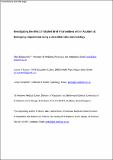Files in this item
Investigating the effect of Alcohol Brief Interventions within Accident & Emergency departments using data informatics methodology
Item metadata
| dc.contributor.author | Baldacchino, Alex | |
| dc.contributor.author | O'Rourke, Louise | |
| dc.contributor.author | Humphris, Gerry | |
| dc.date.accessioned | 2019-04-29T23:37:26Z | |
| dc.date.available | 2019-04-29T23:37:26Z | |
| dc.date.issued | 2018-07-01 | |
| dc.identifier | 252523513 | |
| dc.identifier | b9b505a1-200b-491d-94d3-097981027792 | |
| dc.identifier | 85046636826 | |
| dc.identifier | 000436912700007 | |
| dc.identifier.citation | Baldacchino , A , O'Rourke , L & Humphris , G 2018 , ' Investigating the effect of Alcohol Brief Interventions within Accident & Emergency departments using data informatics methodology ' , Drug and Alcohol Dependence , vol. 188 , pp. 47-52 . https://doi.org/10.1016/j.drugalcdep.2018.03.035 | en |
| dc.identifier.issn | 0376-8716 | |
| dc.identifier.other | ORCID: /0000-0002-5388-7376/work/60196775 | |
| dc.identifier.other | ORCID: /0000-0002-4601-8834/work/64033872 | |
| dc.identifier.uri | https://hdl.handle.net/10023/17608 | |
| dc.description | Funding: NHS Fife R&D, NHS Education for Scotland and the Medical School, University of St Andrews supported the project. | en |
| dc.description.abstract | Background: Alcohol Brief Interventions (ABI) have been implemented throughout Scotland since 2008 aiming to reduce hazardous drinking through a Scottish government funded initiative delivered in a range of setting including Accident and Emergency (A&E) departments. Purpose: To study the extent to Alcohol Brief Interventions (ABI) is associated with later health service use. Method: An opportunistic informatics approach was applied. A unique patient identifier was used to link patient data with core datasets spanning two years previous and two years post ABI. Variables included inpatient attendance, outpatient attendance, psychiatric admissions, A&E attendance and prescribing. Patients (N = 1704) who presented at A&E departments reported an average alcohol consumption of more than 8 units daily received the ABI. Fast Alcohol Screening Test (FAST) was used to assess patients for hazardous alcohol consumption. Multilevel linear modelling was employed to predict post-intervention utilisation using pre-ABI variables and controlling for person characteristics and venue. Results: Significant decrease in A&E usage was found at one and two years following the ABI intervention. Previous health service use was predictive of later service use. A single question (Item 4) on the FAST was predictive of A&E attendance at one and two years. Conclusions: This investigation and methodology used provides support for the delivery of the ABI. However it cannot be ascertained as to whether this is due to the ABI, or simply as a result of making contact with a specialist in the addiction field. | |
| dc.format.extent | 683861 | |
| dc.language.iso | eng | |
| dc.relation.ispartof | Drug and Alcohol Dependence | en |
| dc.subject | Alcohol Brief Intervention | en |
| dc.subject | Screening | en |
| dc.subject | Informatics | en |
| dc.subject | RA0421 Public health. Hygiene. Preventive Medicine | en |
| dc.subject | Medicine(all) | en |
| dc.subject | NDAS | en |
| dc.subject | SDG 3 - Good Health and Well-being | en |
| dc.subject.lcc | RA0421 | en |
| dc.title | Investigating the effect of Alcohol Brief Interventions within Accident & Emergency departments using data informatics methodology | en |
| dc.type | Journal article | en |
| dc.contributor.institution | University of St Andrews. School of Medicine | en |
| dc.contributor.institution | University of St Andrews. Population and Behavioural Science Division | en |
| dc.contributor.institution | University of St Andrews. Centre for Minorities Research (CMR) | en |
| dc.contributor.institution | University of St Andrews. WHO Collaborating Centre for International Child & Adolescent Health Policy | en |
| dc.contributor.institution | University of St Andrews. Health Psychology | en |
| dc.contributor.institution | University of St Andrews. St Andrews Sustainability Institute | en |
| dc.identifier.doi | https://doi.org/10.1016/j.drugalcdep.2018.03.035 | |
| dc.description.status | Peer reviewed | en |
| dc.date.embargoedUntil | 2019-04-30 |
This item appears in the following Collection(s)
Items in the St Andrews Research Repository are protected by copyright, with all rights reserved, unless otherwise indicated.

